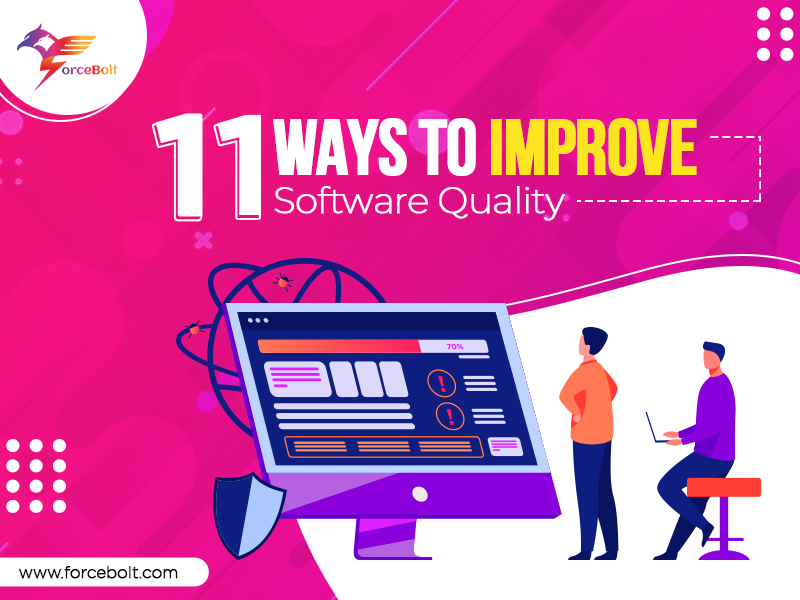Sharing is caring!
Are you constantly on the hunt for cost-effective solutions to increase the quality of your software? The way you manage software quality has become a critical component of project management at every step. The cost-effectiveness and higher performance of your projects will be enabled by high-quality software. If you are a full stack development company, finding ways to adopt effective testing procedures as soon as possible aids in the detection and resolution of issues. It’s a win-win situation when challenges are solved early in the project management process. Moreover, better software and lower expenses amplify efficiency. On the other hand, poor software quality increases issues and can become a time-consuming and costly exercise.
Instead of wasting time resolving software bugs, you may concentrate on completing a high-quality product. In this guide, we will explore 11 effective ways to improve software quality for increasing productivity and excellence on your next project.
1. Test At An Early Stage
It is critical to test early and often to improve software quality. Early testing will ensure that any flaws don’t turn into more significant problems. The more serious the flaw, the more expensive it is to correct it. The sooner you involve your testers, the better. Early involvement of testers in the software design process ensures that they take care of any problems or flaws as they arise and resolve them before the issue develops exponentially.
2. Ensure Quality Control
In collaboration with developers, testers can monitor quality controls and raise awareness to guarantee that standards are consistently maintained. Quality control begins at the beginning and continues throughout the delivery process. The development of the project software strategy might be aided by a positive relationship between testers and developers. Moreover, a planned approach for dealing with code errors and bugs can be ensured by using a systematic methodology for quality control.
3. Implement Quality Assurance
We have established the importance of testing at the beginning of software development; nevertheless, testing does not end there. Quality assurance should be present at all times during the software development process. It is a type of team-provided governance that instills trust in the overall software quality. Assurance testing monitors and certifies that the techniques used to deliver outcomes have been tracked and are working correctly.
4. Embrace Innovations
Although it is essential to have testing structures and quality controls in place, there should always be an opportunity for innovation. Automation of testing, where possible, to save time spent on rules is a fantastic method for creativity. Moreover, innovations can lead to improvements in software quality that can change the way projects are delivered. It is important to promote research and development. Encourage teams to explore, experiment, and investigate regularly.
5. Communicate Effectively
For any relationship, whether personal or professional, communication plays a major role. To increase software quality, all project participants must have access to up-to-date information via open lines of communication. Fluid communication can come in a variety of shapes and sizes. To keep the entire team on the same page, it’s critical that all team members, regardless of seniority, have access to KPIs. Another benefit of fluid communication is that all stakeholders can provide feedback to the team to guarantee that all expectations are satisfied.
6. Plan Well
The software comes with its process of evolution and is constantly changing. Web browsers, hardware, libraries, and operating systems are only a few of the external components that it relies on. These continual external elements require regular monitoring through checks and balances. It’s critical to recognize that software is reliant on these external influences. It allows you to have the software quality verified against external variables at each stage of the process and evaluate how it stands up. As a result, you’ll be able to avoid software dissonance while also maintaining software quality.
7. Attitude Towards The Project
This stage is a representation of your team’s mentality. Creating a project communicates to your team that you are working toward a specific goal. We are, however, well aware that software is subject to change. If your team approaches software development with the attitude of producing a product, they are more likely to make high-quality software adaptive to change and withstand the test. So, focus on delivering tiny incremental improvements rather than a single large project, and your team will eventually improve its quality.
8. Maintain A Risk Register
To manage risks, a risk register is an excellent management tool. Although a risk register is more commonly associated with financial auditing, it is nevertheless an essential component of software development. A risk register will present a list of clearly identifiable risks to everyone aligned on a software project and then grade them in terms of the relevance of completing the project. Because its development actively leads to risk mitigation, a risk register works well for software quality. It must include describing the risks, chances of the risk occurrence, the person who can identify and take action against it, and more.
9. Long-Term Strategy
Since decisions are made to address long-term concerns, distant future thinking yields high-quality software. Some of the benefits of long-term thinking in software development include creating coding standards, minimizing errors, time-consuming processes, and fixing bugs. The project managers must keep in mind that short-term advantages and quick gratification must not be neglected while completing long-term goals. Adequate planning will ensure that all stakeholders prioritize software quality.
10. List Your Deliverables
It is essential to ensure that your team spells out precisely what they will provide right at the start of the project. A clear and comprehensive outline of what the project will provide can ensure that quality is prioritized right from the start. It also guarantees that money, resources, and time are all adequately allocated to achieve high-quality results. Shortcuts will only be done to meet budgets and timeframes if there are no clear deliverables.
11. 3 Rs For Quality Check
It is not by chance that high-quality software is produced. This is why you must do the following three things at all times:
Review – One of the most important aspects of assuring software quality is testing. It guarantees that standards are consistently met. Defects, problems, and distractions must be identified and addressed before they go out of hand.
Revise – Examine what has worked in the past during the software development process. Use what’s working and see whether innovation can help you improve the quality of your program even further.
Remember – When delivering excellence, keep in mind what worked and what didn’t. Keep an up-to-date record of each project’s positives and negatives and refer to it frequently when starting a new one.
Conclusion
To regulate the quality of programs produced, software products are standardized against several criteria. For a full stack development company, it is vital to spend time and effort on this feature to minimize coding errors and the resulting financial losses if too many flaws are identified after delivery. This is mainly accomplished by extensive testing during the development process, peer review, and selecting good metrics individually.
Looking for an angularjs development company that will use the latest technology stack to improve the quality of your software? Get in touch with the ForceBolt team of experts who will provide quality assurance services and end-to-end strategy that will deliver a better product to your consumers.

Abhishek Singh
Full Stack Technical Lead
A highly motivated Senior Full Stack Developer who is self-driven and actively looks for ways to contribute to the team. He possesses rich expertise and deep knowledge about a good software development process that includes documentation, testing, documentation, and collaboration. With solid communications and reasoning skills, he delivers high performance and quality in his projects. He is always open to assist other teams in understanding project requirements so that collaboration can happen in the best possible ways in an environment conducive to the business.













